When in Hanoi, everyone should visit and experience the historical and cultural heritage site, the complex of relics related to Vietnam’s first university, which is the Temple of Literature – National University. Below are some of the most comprehensive and detailed tips for exploring this place that DanangPrivateCar.com’s wants to share with you.
Table of Contents
Overview of the Temple of Literature – National University
- Location: 58 Quoc Tu Giam Street, Van Mieu, Dong Da, Hanoi
- Opening hours: Daily
- Summer (May to October): 07:30 – 17:30
- Winter (October to April): 08:00 – 17:00
- Entrance fee:
- Adults: 30,000 VND for both Vietnamese and foreigners
- Students: 15,000 VND (with student ID)
- Children under 15: Free
- Dress code: No tank tops or short skirts, always remove hats in the solemn area.
History of Formation
Initiated in August 1070 under the reign of King Ly Thanh Tong, the Temple of Literature, besides its function of worshiping Confucian scholars, also served as the first royal university, educating royal princes. The first student of this royal school was Prince Ly Can Duc, later known as King Ly Nhan Tong. In 1076, this first student, upon ascending the throne, established a school next to the Temple of Literature. Since it was exclusively for the children of royal and noble families, it was named Quoc Tu Giam.
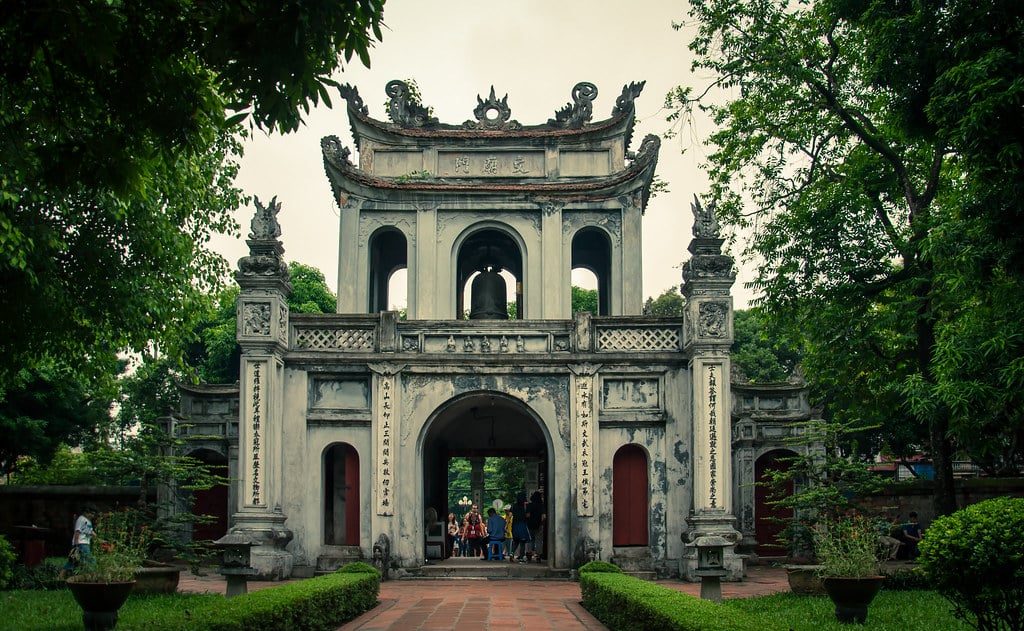
In 1253, during the reign of King Tran Thai Tong, Quoc Tu Giam was renamed the National Academy. During this time, the school expanded and admitted the children of commoners as long as they demonstrated outstanding academic ability. In the reign of King Tran Minh Tong (1300 – 1357), Chu Van An was appointed as the principal of Quoc Tu Giam, a position equivalent to today’s school principal. He was responsible for managing all activities of Quoc Tu Giam and directly teaching Prince Tran Vuong.
Architecture
The architectural complex of the Temple of Literature is a large rectangular area covering 54,331 square meters, reflecting the construction style of the early Nguyen Dynasty. The Temple of Literature is enclosed by four solid ancient brick walls.
The layout of the Temple of Literature follows the Confucian principles, arranged layer by layer, zone by zone, along the North-South axis. Upon entering through the main gate, there are four pillars and two stelae of horses on either side. Inside, the Inner Courtyard is separated by a water pond, a spacious courtyard, or a walkway with a wide gap on both sides. Before entering each zone, you will pass through a system of doors, including a main door and two side doors on each side. All entrance gates to the Inner Courtyard, shrines, worship halls, and the Thai Hoc House are designed with roofs adorned with dragon and moon motifs, reflecting the ancient Eastern architectural style.
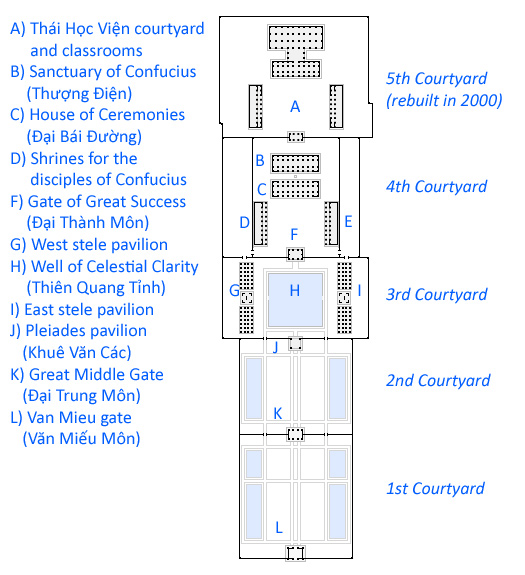
How to Get to the Temple of Literature – National University?
To reach the Temple of Literature – National University, visitors can choose from the following options:
- By Bus: Visitors can take buses such as route 32, 41, 23, 38, or 02 and get off at the nearest stop to the Temple of Literature, then walk to the destination.
- By Double-decker Bus: This is a newly introduced sightseeing service in the capital in recent years. This service not only allows you to visit the Temple of Literature but also takes you to explore all other famous landmarks and historical sites in Hanoi in a professional and convenient manner.
- Using Inner-city Bicycle Tours: This service, provided by travel companies, aims to offer a unique and enjoyable experience for tourists exploring Hanoi by bicycle.
- Taxi or Motorbike Taxi (Xe Ôm): In Hanoi, motorbike taxis and taxis are readily available, making it easy for visitors to call a ride to the Temple of Literature – National University for exploration.
- Personal Vehicle: If traveling by personal vehicle, visitors can consult maps or ask locals to choose the most suitable route, avoiding one-way streets.
Additionally, for those seeking a fast and convenient means of transportation that provides door-to-door service and the flexibility to visit multiple attractions in Hanoi, they can consider booking a private car with a driver in Hanoi From DanangPrivateCar.com. With a professional team of drivers with years of experience, this service ensures the fastest and safest journey for your exploration.
Points of Interest in the Temple of Literature – National University
Van Lake
Located directly in front of the gate of the Temple of Literature, Van Lake, also known as Giám Lake or Minh Duong Lake, is the first point of interest to explore when visiting the Temple of Literature. Historical records describe Van Lake as a large lake, stretching up to 11,900 square meters within the overall complex of the Temple of Literature. In the middle of Van Lake stands Kim Chau mound, where Thuy Duong Pavilion was built. Thuy Duong Pavilion is where literary discussions of Confucian scholars in the ancient capital took place.
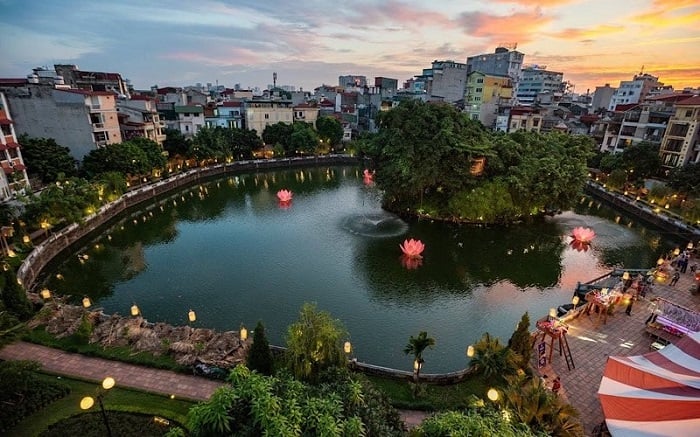
Van Mieu Mon (Literature Temple Gate)
Van Mieu Mon is the outer triple gate of the historical site, consisting of three doors with a two-story tall main door. The upper floor bears the inscription “Van Mieu Mon” in ancient Chinese characters. In front of Van Mieu Mon are four pillars representing the main entrance and two stelae of horses on either side. Tradition has it that in the past, whether generals or court officials, anyone passing through Van Mieu had to dismount and walk at least from one stela of horses to the other before continuing. This tradition reflects the solemn and significant status of the Temple of Literature.
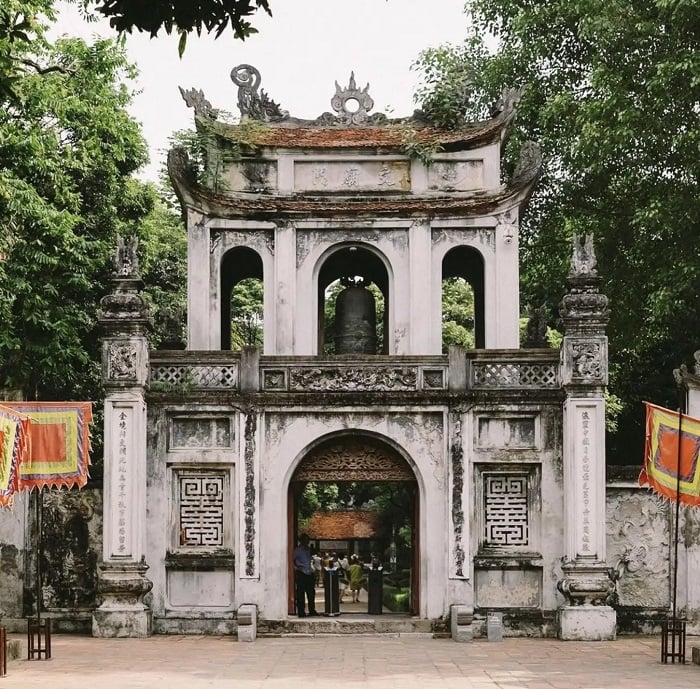
Dai Trung Mon (Great Central Gate)
Dai Trung Mon is the second gate of the Temple of Literature, leading straight from the main gate, Van Mieu Mon. Dai Trung Mon consists of three bays built on a high brick base with a double-sloped tile roof in the style of ancient communal houses. In front of and behind Dai Trung Mon is a large space filled with grass, a water pond, and parallel pathways, creating a sense of serenity and elegance, typical of a literary sanctuary.
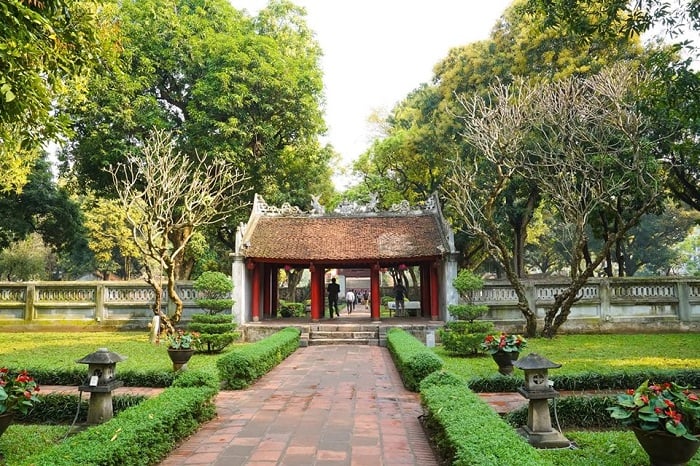
Khue Van Cac (Stelae of Doctors)
Khue Van Cac is a two-story square pavilion nearly 9 meters high, including four lower and four upper roofs. This structure, built by General Nguyen Van Thanh in the year 1805 under the Nguyen Dynasty, features a unique architecture with the lower level supported by four square brick pillars, each one meter long, intricately carved with sophisticated and delicate floral motifs. The upper level of Khuê Văn Các is a wooden structure lacquered in gold, with a red-tiled roof stacked in two layers, creating a distinctive eight-roofed structure. The four walls of the upper level are adorned with round windows, symbolizing the sun or the pole star radiating light.
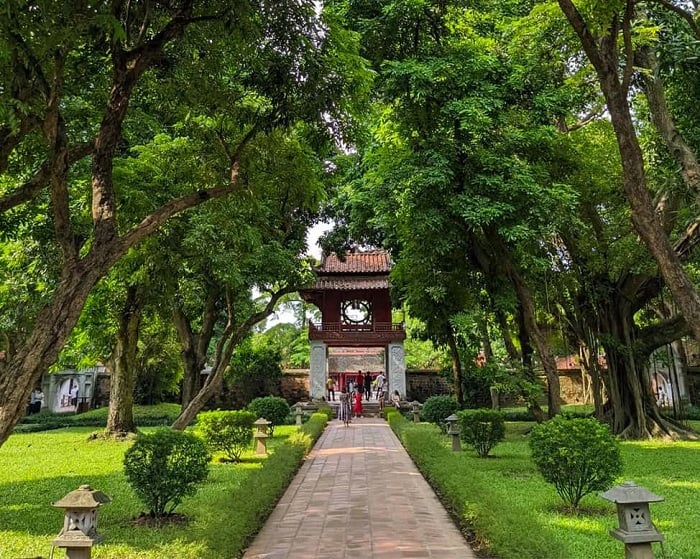
Thien Quang Well, Doctoral Steles
Thien Quang Well is built in a square shape, symbolizing the earth, located just behind Khuê Văn Các, with round gates representing the sky. These two symbols imply that all the essence of the earth and sky converges at the cultural and educational center in the heart of the ancient imperial city of Thang Long.
On both sides of Thien Giang Well are two rows of large stone steles called Doctoral Steles. Each stone stele is a unique and intricately carved artistic work, carrying profound spiritual significance. These 82 doctoral steles are erected on the backs of 82 stone turtles, recognizing and honoring the achievements of 82 top scholars in the imperial examinations of ancient Vietnamese dynasties.
Dai Thanh Mon, Worship Area
Similar to Dai Trung Mon, Dai Thanh Mon also has three bays with a central row of columns and two rows of columns in front and behind the gate. Passing through Dai Thanh Mon, visitors will arrive at a spacious brick-paved courtyard leading to the central area of the Quoc Tu Giam complex, the area of worship called Dai Bai Duong.
Dai Bai Duong consists of nine bays, but only the two side walls are present, leaving the front and back sides open. This was the place for ceremonial rituals during ancient spring rituals. In Dai Bai Duong, only the central bay has an altar for incense, while the other bays are empty.
Nha Tien Duong, Hau Duong (Front Hall, Back Hall of Thai Hoc Area)
This entirely new construction was completed in 1999 on the foundation of the Khai Thanh Temple. The Khai Thanh Temple is the last area of the Temple of Literature – National University. The temple worships the parents of Confucius, separated from the Worship Area by a wall with a small gate. The Khai Thanh Temple is built on the foundation of the old Thai Hoc Area or Quoc Tu Giam. The Khai Thanh Temple also has a U-shaped layout with Tả Vu and Hữu Vu on both sides. In 1947, this area was completely destroyed by the French.
Nha Tien Duong has nine bays, displaying artifacts related to the traditional values of filial piety, respect for knowledge, and devotion to Confucianism. It is also a place for organizing scientific, cultural, and artistic workshops of the Vietnamese people.
Hau Duong has two floors. The first floor has nine bays and two roofs, honoring the Great Doctor Chu Van An, displaying information about the Temple of Literature – National University of Thang Long, and the Nho Hoc education system in Vietnam. The second floor has five bays, dedicated to honoring the predecessors who contributed to the construction of the Temple of Literature – National University and the Nho Hoc education system of Vietnam. These include Kings Ly Thanh Tong, Ly Nhan Tong, and Le Thanh Tong.
Khai Thanh Temple
Situated at the rear of the historical site is Khai Thanh Temple. This is the place where the foster parents of Confucius, Thuc Luong Ngot and Nhan Thi, are worshipped. In the past, Khai Thanh Temple was a residential area with 150 rooms for scholars. In 1946, during the French colonial period, Khai Thanh Temple was heavily damaged by gunfire and completely destroyed. Subsequently, the temple was reconstructed and has been preserved to this day.
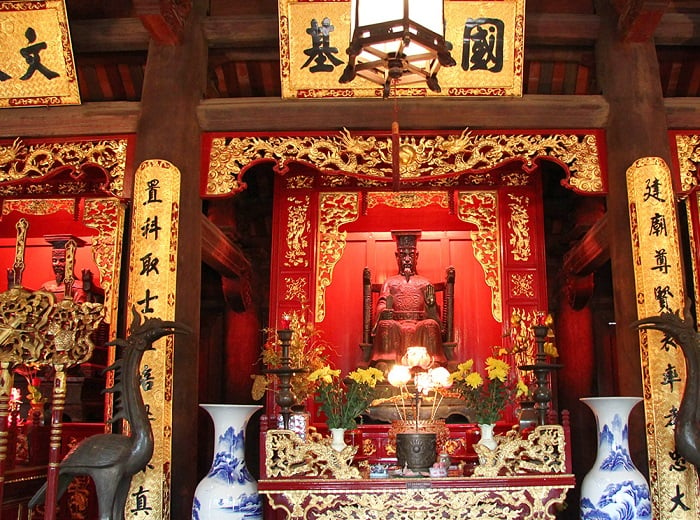
Tourist Attractions in the Vicinity of the Temple of Literature – National University
Nestled in the heart of the capital city, the Temple of Literature – National University serves as a gateway to an array of remarkable landmarks. After immersing oneself in the historical richness of this cultural site, visitors can extend their exploration to nearby attractions. Here are some enticing suggestions for places in close proximity to the Temple of Literature:
Hanoi Flag Tower
Located just 1.1 kilometers away, the Hanoi Flag Tower stands tall as a symbol of Vietnam’s rich history. Visitors can climb to the top for panoramic views of the city and gain insights into its storied past.
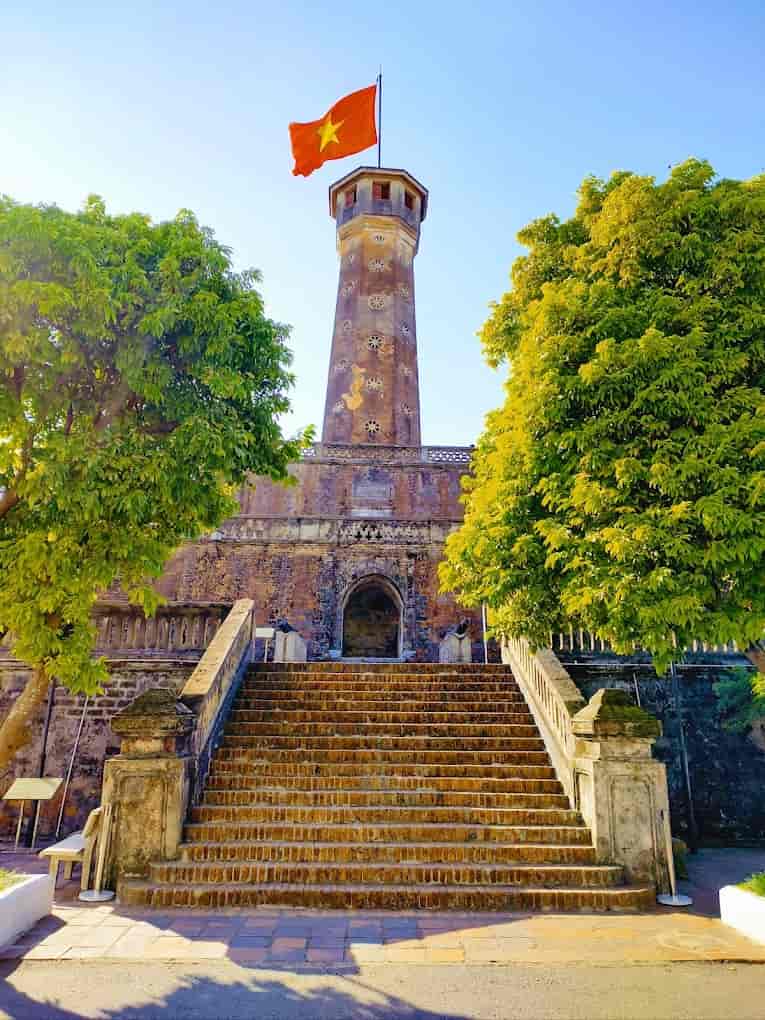
Imperial Citadel of Thang Long
A mere 1.2 kilometers from the Temple of Literature, the Imperial Citadel of Thang Long beckons with ancient charm. This UNESCO World Heritage Site boasts well-preserved remnants of Vietnam’s feudal era.
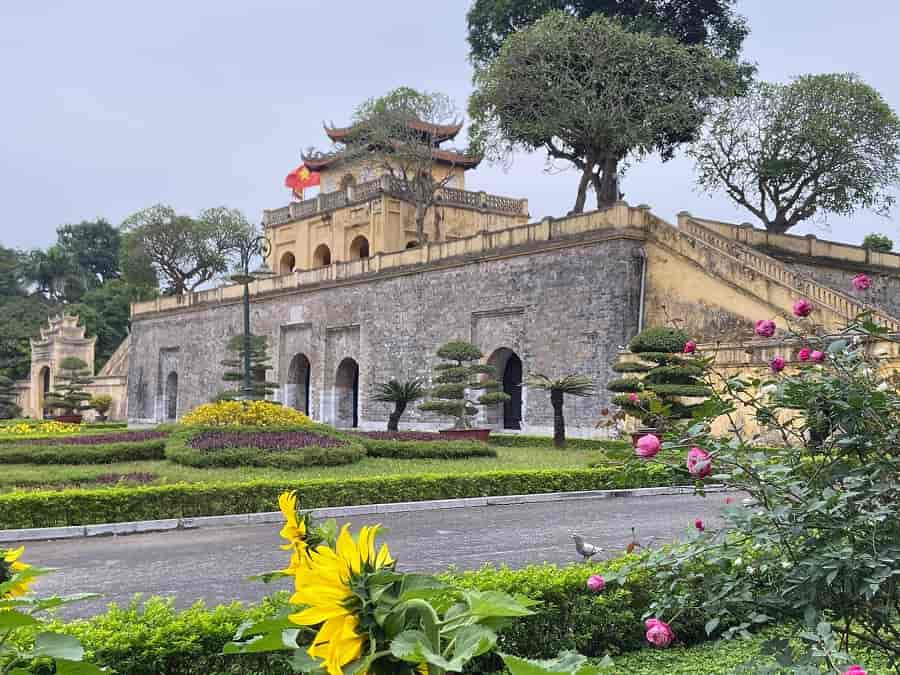
Ho Chi Minh Mausoleum
A short 1.6-kilometer journey leads to the solemn Ho Chi Minh Mausoleum, where the revered leader’s embalmed body rests. The surrounding Ba Dinh Square is witness to significant historical events.
Hoa Lo Prison Historical Site
A historical gem situated 1.9 kilometers from the Temple of Literature, Hoa Lo Prison, also known as the “Hanoi Hilton,” provides a poignant glimpse into Vietnam’s struggle for independence.
Each of these attractions contributes to the rich tapestry of Vietnam’s history and culture. Exploring these sites in the vicinity of the Temple of Literature provides a comprehensive and immersive experience for visitors eager to delve into the multifaceted heritage of Hanoi.
Notes for Visiting the Temple of Literature
- Absolutely no smoking or bringing flammable materials within the Temple of Literature premises.
- Only light one incense stick during the offering ritual in the designated area.
- Walk lightly, speak softly, and maintain the cleanliness of the environmental landscape.
- Photography is allowed, but refrain from making loud noises or disturbing the areas of worship.
- Bring cash to purchase tickets, as the ticket booth may not accept card payments.
- Do not harm the artifacts, refrain from writing or drawing on surfaces, avoid climbing on structures, and do not touch the turtle heads, Doctoral Steles, and other displayed artifacts.
Enduring the passage of many years and the ebbs and flows of history, the Temple of Literature – National University has steadfastly maintained its artifacts and significant cultural values. This landmark stands as an emblematic testament to the pinnacle of education and the admirable traditions of the Vietnamese people. Don’t miss this captivating landmark on your journey to explore the heart of Hanoi.

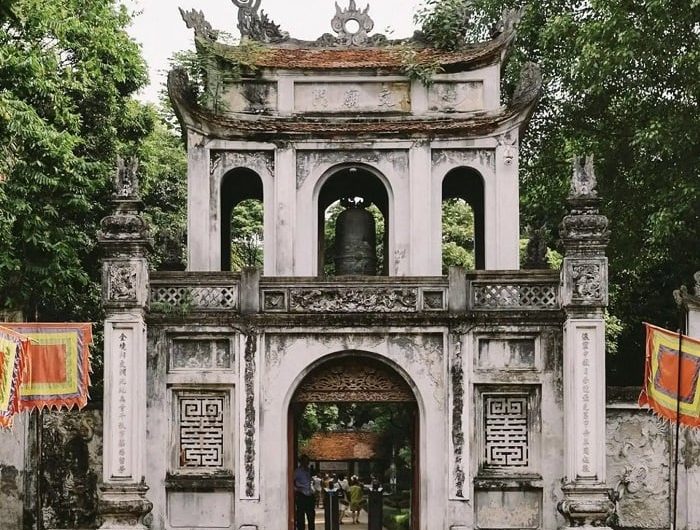
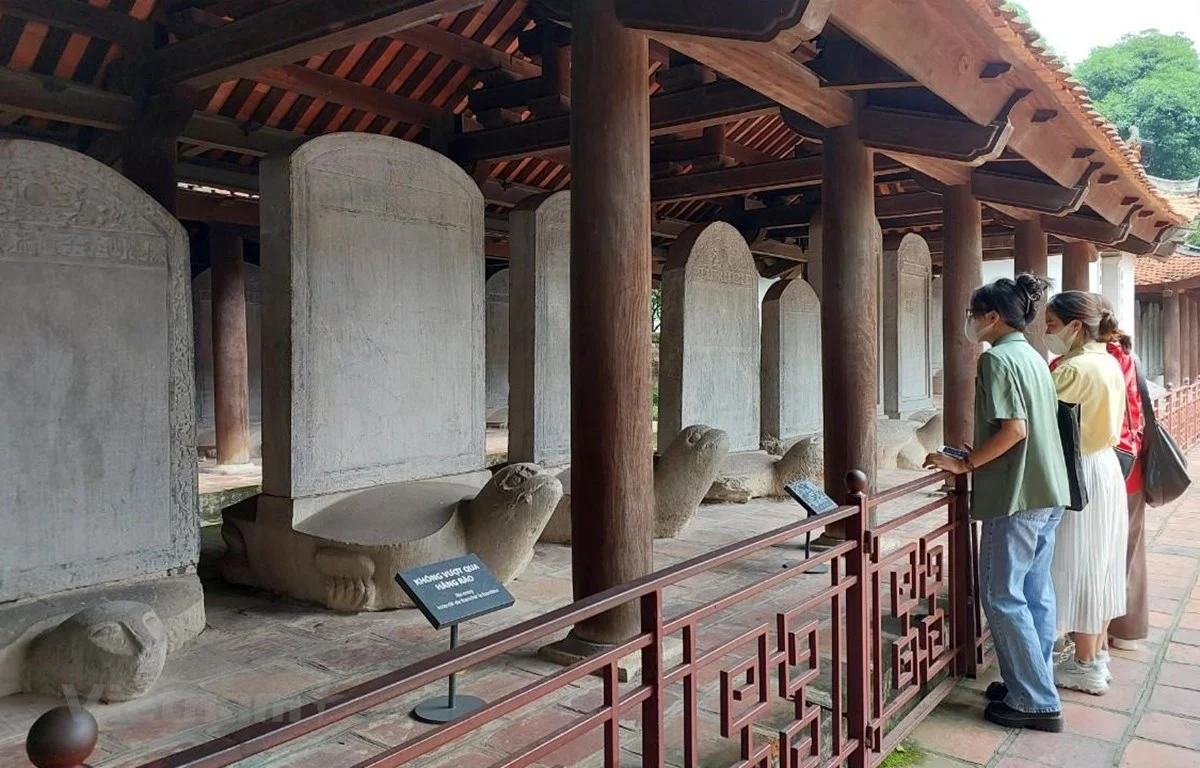
Comments